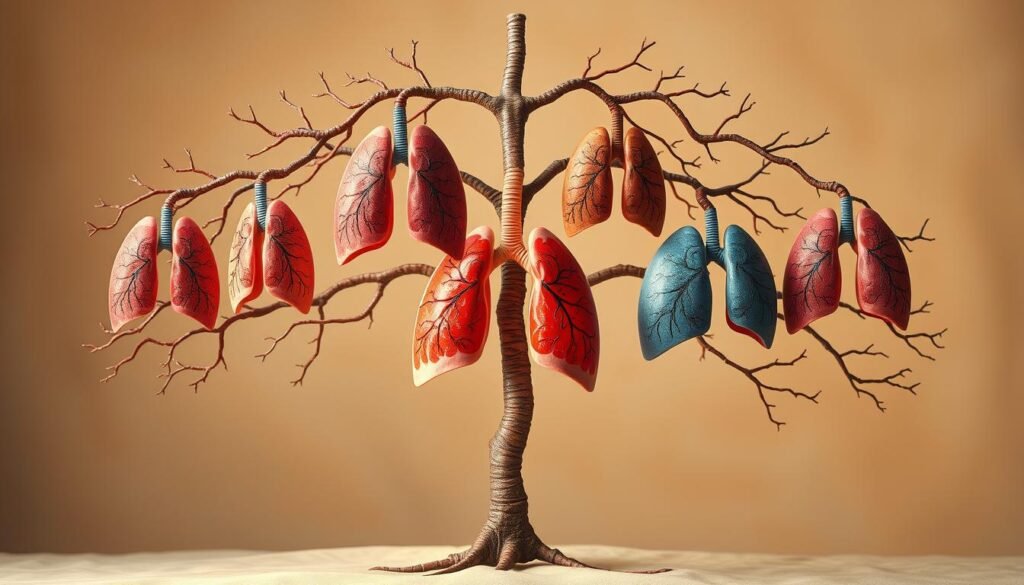Did you know smoking causes around 80%-90% of lung cancer deaths? This shocking fact shows why it’s vital to prevent lung cancer. And it’s not just about stopping smoking. It also means living a healthy life, tackling environmental issues, and choosing the right foods.
In this piece, we will explore ways to prevent lung cancer. We’ll look at how changing your lifestyle and dealing with risk factors can help. This could lower your chance of getting lung cancer.
Key Takeaways
- Smoking is responsible for a majority of lung cancer deaths.
- Radon exposure contributes to a significant percentage of lung cancer cases.
- Workplace exposures to carcinogens increase lung cancer risk.
- A diet rich in fruits and vegetables may provide some protection against lung cancer.
- Physical activity can help lower the risk of lung cancer.
- Quitting smoking at any age dramatically reduces the risk of lung cancer.
- Screening can help detect lung cancer early in high-risk individuals.
Understanding Lung Cancer Risks
Lung cancer is a big health challenge around the world. It’s caused by different things, like smoking and secondhand smoke. There are also dangers from radon and polluted air. Knowing these risks helps fight cancer better.
Smoking is the top reason people get lung cancer, causing about 80% of deaths. Smokers have a much bigger risk than non-smokers. Smoking things like marijuana also brings harmful stuff into the lungs.
Radon gas is the second big cause of lung cancer in the U.S., especially for those who don’t smoke. Making your home safer can really cut down this risk.
Getting exposed to bad stuff at work increases cancer risk too. Things like asbestos and diesel fumes are really harmful. Having family members with lung cancer adds more risk, especially if they got sick young.
Understanding and avoiding these risks can make you healthier. Taking action early can greatly reduce your chances of getting lung cancer. To learn more about stopping lung cancer, visit cancer prevention resources.
The Importance of Not Smoking
It’s vital to understand how smoking links to lung cancer. Smoking is behind about 87% of lung cancer deaths in the U.S. For men, smoking ups the lung cancer risk 23 times. Women who smoke face a risk 13 times higher than non-smokers. Smoking fills the body with harmful substances, raising the chances for lung cancer and other diseases.
Impact of Smoking on Lung Cancer Risk
Smoking’s dangers go beyond lung cancer. It’s the top cause of cancer deaths in the U.S. Tobacco smoke is a major factor in lung cancer. But, living healthier can lower lung cancer risks even for smokers. Quitting can halve the risk in five years, showing how vital it is to stop.
Benefits of Quitting Smoking
Stopping smoking has many benefits, like cutting lung cancer risk. Quitting can add as much as 10 years to someone’s life. If you quit by 40, you drop the death risk from smoking by about 90%. Benefits start quickly with better taste, smell, oral health, and more energy. The American Lung Association and CDC offer help to quit. This means better lung health and overall life quality.
How Can You Reduce the Risk of Lung Cancer
Knowing how to cut your risk of lung cancer is vital. It can greatly affect your future health. Many steps can lessen your chance of getting lung cancer. This is good for both now and later.
Key Prevention Strategies
There are many ways to decrease your risk. Not smoking is a key one; it makes getting the disease less likely. Staying away from secondhand smoke also helps protect you. Other important steps include:
- Regular health check-ups to spot problems early.
- Keeping a healthy weight with good food choices.
- Being active to stay healthy.
- Learning about the dangers of asbestos and radon.
Long-term Effects of Prevention Efforts
Putting effort into prevention pays off in the long run. Healthy habits, like eating a lot of fruits and veggies, lower lung cancer risk. Being active also leads to better health. Teaching people about these choices helps whole communities live healthier.
Living healthy and following these tips can make life better. It also lowers the chance of lung cancer. Keeping the community involved is key to preventing diseases.
| Prevention Strategy | Benefits |
|---|---|
| Quitting Smoking | Lower risk of lung cancer and improved lung function |
| Avoiding Secondhand Smoke | Reduced risk of lung cancer and better respiratory health |
| Regular Check-ups | Early detection of potential issues |
| Healthy Diet | Lowers cancer risk and promotes overall wellness |
| Physical Activity | Improved fitness levels and reduced risk of chronic diseases |
Avoiding Secondhand Smoke
Knowing why secondhand smoke is bad is key to staying healthy. It has over 7,000 harmful chemicals. Around 70 of these are cancer-causing. The risks from secondhand smoke aren’t just about cancer. They also increase your chances of heart disease and strokes, even if you’re around it for a short time.
Understanding Secondhand Smoke
Secondhand smoke is a serious danger. In the U.S., it causes about 3,400 nonsmokers to die from lung cancer every year. Babies whose mothers are around smoke while pregnant face a higher risk of cancers like lymphoma and leukemia.
Kids exposed to this smoke are more likely to get lung infections, have asthma problems, and ear infections. It’s important to limit smoke exposure by talking about health risks with smokers, especially if your family has health troubles from smoking.
Creating a Smoke-Free Environment
Making places smoke-free helps cut down on smoke exposure. Countries that have clean air laws inside show this works well. These laws keep people safe from tobacco smoke in public spots and homes. Encouraging smokers to respect these smoke-free places is possible by kindly talking about allergies or discomfort with smoke.

We should protect ourselves from all types of smoking, including e-cigarettes. These also have dangers due to what’s in their vapors. It’s important for places to have strong no-smoking policies. This helps keep everyone safe. Talking more about the dangers of secondhand smoke can help improve everyone’s health and lower lung cancer numbers.
| Health Issues from Secondhand Smoke | Statistics |
|---|---|
| Annual lung cancer deaths among nonsmokers | 3,400 |
| Risk increase for infants exposed during pregnancy | Higher |
| Number of chemicals in secondhand smoke | More than 7,000 |
| Carcinogens in secondhand smoke | About 70 |
| Health issues in children exposed | Increased asthma, lung infections |
Getting Your Home Tested for Radon
Radon is a gas found in nature that can harm your health. It’s the top reason non-smokers get lung cancer, so knowing about radon exposure risks is crucial. Since radon is invisible and has no smell, it can build up in homes, especially basements and energy-efficient ones. That’s why it’s important to test for radon.
What is Radon and Why is it Hazardous?
Radon is very dangerous. The EPA says most American homes have radon levels around 1.3 pCi/L. If levels are between 2 pCi/L and 4 pCi/L, you need to act. And if they reach or exceed 4 pCi/L, it’s urgent to get professional help.
Studies show radon exposure is linked to many lung cancer deaths yearly. Smokers are at even higher risk. They’re more likely to get lung cancer from radon, usually 5 to 25 years after being exposed.
How to Test for Radon in Your Home
You can check your home’s radon levels yourself or get professional help. There are two main radon testing methods:
- Short-term kits measure radon for 2 to 90 days, giving quick results.
- Long-term kits check radon for more than 90 days, giving a better average level for the whole year.
If you find high radon in your home, there are ways to lower it. You might need to improve ventilation or seal cracks in the foundation. Using vent pipes and fans is common too. Once you’ve fixed it, test your home every two years to keep radon down.
| Radon Level (pCi/L) | Recommended Action |
|---|---|
| Less than 2 | No action needed |
| 2 to 4 | Think about taking action |
| 4 or greater | Call a pro |
Checking your home for radon is key for keeping your family safe. Because radon is so risky, testing regularly is a must.
Reducing Occupational Exposures
Workers face major risks from occupational cancer due to hazardous substances. It’s vital to know about workplace carcinogens to spot dangers. This knowledge leads to effective safety measures. By working together, we can greatly reduce lung cancer risks and other diseases at work.
Identifying Carcinogens at Work
Many workers deal with cancer-causing agents daily. Known carcinogens in workplaces include:
- Asbestos
- Coal smoke
- Diesel exhaust
- Crystalline silica
In the U.S., about one million workers are exposed to diesel exhaust and two million to silica. Occupational exposures could be behind 7% to 19% of cancers worldwide. This shows the urgent need for work-related cancer prevention through better knowledge and rules.
Safety Guidelines for Prevention in the Workplace
Creating strong safety rules is key to lowering workplace hazard risks. Employers should:
- Hold regular training for workers on health rules and safe practices.
- Use protective gear to shield employees from dangerous substances.
- Check often to ensure work areas follow safety measures.
- Build a safety-first culture where workers report dangers freely.
Following these steps helps make work safer. It lowers the chance of employees getting lung cancer from their jobs.
| Carcinogen | Typical Source | Number of Exposed Workers (Approx.) |
|---|---|---|
| Diesel Exhaust | Transportation, Construction | 1 million (U.S.) |
| Crystalline Silica | Mining, Construction | 2 million (U.S.) |
| Asbestos | Construction, Shipbuilding | Varies widely |
| Coal Smoke | Mining, Energy Production | Varies widely |
By focusing on identifying carcinogens and setting strong safety rules, we can change the picture of occupational cancer. This results in safer workplaces for everyone.
Managing Air Pollution Exposure
Air pollution affects our health, especially lung cancer, through both outdoor and indoor air quality. Outdoors, car exhaust, factories, and other sources pollute the air. Inside, things like cleaning products and poor airflow can make air harmful. To stay healthy, it’s vital to control our exposure to polluted air.
Understanding Outdoor and Indoor Air Pollution
Most people in developed countries are indoors about 90% of their day, with 70% of that at home. This fact highlights the importance of keeping indoor air clean. Though staying inside can protect us on days when outdoor air is very polluted, indoor air can still contain up to 80% of the outdoor pollution level. This is because of chemical reactions on indoor surfaces.
Steps to Reduce Exposure to Air Pollution
There are ways to lessen our contact with polluted air. Here are some key steps:
- Use air purifiers to clean the air inside our homes.
- When pollution levels are high, skip outdoor workouts and activities.
- Make sure our homes are well-ventilated and insulated to control air flow.
- Choose household products that are kind to the environment to reduce indoor pollution.
- Keep track of air quality reports with tools like the Air Quality Health Index.
- Help reduce overall pollution by using public transport, biking, or walking instead of driving.
By following these recommendations, we not only protect our own health but also support efforts to clean up the air. Understanding the link between air pollution and lung cancer shows how important it is to take action to reduce our exposure.
Maintaining a Healthy Diet
Eating well is key to lowering lung cancer risk and improving your health. Studies show eating healthily helps prevent lung cancer. Including certain foods boosts your body’s cancer defense and supports a healthy way of life. Changing what you eat can greatly benefit your health.
Foods that May Reduce Lung Cancer Risk
Fruits and veggies are vital for preventing cancer. They’re full of important nutrients. Antioxidants and phytochemicals in them fight inflammation and oxidative stress.
- Leafy greens like spinach and kale
- Cruciferous vegetables including broccoli and Brussels sprouts
- Fruits such as berries, oranges, and apples
- Legumes like beans and lentils
Eating a variety of foods is crucial. It ensures you get different nutrients and health perks. Such choices are key in nutrition for cancer prevention.
The Importance of Fruits and Vegetables in Your Diet
Fruits and veggies are not just nutritious. They also cut cancer risk. Eating them regularly lowers your chance of getting lung cancer and other types. A diet focused on these foods reduces damage from pollution and smoking.

Including more fruits and vegetables offers major health advantages. It uses the power of nature to protect you. A diet rich in these foods lets you control your health better.
| Food Group | Key Benefits |
|---|---|
| Leafy Greens | High in vitamins and minerals, anti-cancer properties |
| Cruciferous Vegetables | Rich in glucosinolates, known to reduce cancer risk |
| Berries | High in antioxidants, combat oxidative stress |
| Legumes | Protein-rich, high in dietary fiber |
Incorporating Regular Exercise
Regular exercise is key for preventing lung cancer and improving your health. Experts say adults should work out moderately for 30 minutes, five days a week. Regular workouts can lower your chance of getting lung cancer. They help you stay in shape, boost your immune system, and make your lungs work better.
There are many ways to work out for your health. Do aerobic exercises like walking or running. Add some strength training, like weight lifting, to help your lungs even more. These activities can make it easier to breathe and give you more energy, which is great for people with lung cancer.
Working out does more than just help your body. People who exercise often feel less anxious and depressed. They also think better and have a lower chance of getting diseases like dementia. This shows why we should support programs and habits that encourage exercise throughout life.
People with lung cancer often don’t exercise enough, which is worrying. Being fit can help you live longer if you have lung cancer. Though we don’t have exact workout rules for lung cancer patients, regular exercise can make them stronger and more able.
Being Aware of Family History
Knowing about lung cancer in your family is key to staying healthy. People with this concern should go for check-ups often. They must also follow healthy routines closely. About 5% to 10% of cancers come from our genes, which shows why it’s crucial to talk with doctors about your family’s health.
Getting genetic counseling helps figure out your risk and what screenings you need. It’s important to learn about your family’s health history. This lets you watch out for specific health issues effectively. Early action can help lower the chances of getting lung cancer.

It’s very important to take steps to prevent lung cancer if it’s in your family. Regular checks can really help, especially if you’re at greater risk. Bad habits like smoking play a big role in getting lung cancer, even if your genes put you at risk. Having a healthy lifestyle and knowing your family history work together to fight lung cancer.
| Risk Factor | Description | Impact on Lung Cancer |
|---|---|---|
| Lung Cancer Family History | Family members have had lung cancer | Higher likelihood of developing lung cancer |
| Genetics and Lung Cancer | Inherited genetic mutations | Increases susceptibility to lung cancer |
| Behavioral Factors | Such as smoking and obesity | Significantly raise risk regardless of family history |
Monitoring Environmental Factors in Your Home
Homeowners must watch how renovations affect indoor air quality. Home improvements can release dangerous chemicals. It’s key to keep an eye on air quality for a healthy home.
Renovation and its Impact on Indoor Air Quality
Before starting renovations, think about the materials you’ll use. Some materials emit harmful substances, like VOCs, that hurt air quality. Keep these in mind:
- Choosing low-VOC paints and finishes
- Selecting non-toxic building materials
- Ensuring ample ventilation during and after renovations to dissipate harmful fumes
Checking your home’s air regularly helps find and fix air quality problems. Making improvements can make your home safer. This can lower the risk of lung cancer and other illnesses.
Conclusion
The battle against lung cancer relies on a well-rounded approach. This includes being aware of our health and taking personal responsibility. While we can’t control certain things like our genes or the air we breathe, we can do a lot ourselves. For instance, stopping smoking, avoiding secondhand smoke, and knowing about dangers like radon and workplace hazards.
Lung cancer affects millions worldwide, making prevention key. A healthy lifestyle is critical. This means eating well, staying active, and getting regular health checks. Such steps can drastically improve our odds of beating lung cancer. Together, we can raise awareness and find better prevention methods.
In this fight, everyone has a part to play. The power of working together, making smart choices, and taking community action is invaluable. By staying vigilant and dedicated, we can cut down the threat of lung cancer. This way, we better our lives and our community’s future.